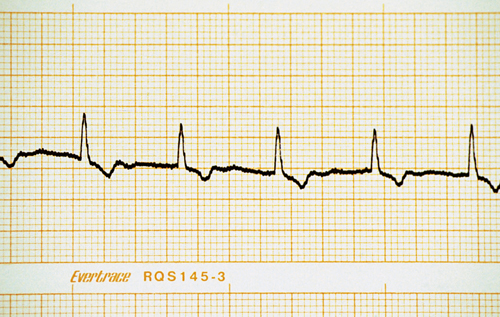Difference between revisions of "Feline Medicine Q&A 01"
Ggaitskell (talk | contribs) |
|||
| (3 intermediate revisions by 2 users not shown) | |||
| Line 17: | Line 17: | ||
*If the paper speed is 25 mm/second, there will be 1500 mm/minute, thus the heart rate is 1500 ÷ distance between two complexes. | *If the paper speed is 25 mm/second, there will be 1500 mm/minute, thus the heart rate is 1500 ÷ distance between two complexes. | ||
*Using the formula in this case, the heart rate is estimated to be 100 beats per minute. | *Using the formula in this case, the heart rate is estimated to be 100 beats per minute. | ||
| − | |l1= | + | |l1=ECG |
|q2=Is the heart rate regular? | |q2=Is the heart rate regular? | ||
|a2= | |a2= | ||
Yes, the heart rate is very regular. | Yes, the heart rate is very regular. | ||
| − | |l2= | + | |l2=ECG |
|q3=Describe the complexes present. | |q3=Describe the complexes present. | ||
|a3= | |a3= | ||
There are no visible P waves and the QRS complexes are wider than they should be (around 0.06 seconds; normal QRS duration is <0.04 seconds). <br><br> | There are no visible P waves and the QRS complexes are wider than they should be (around 0.06 seconds; normal QRS duration is <0.04 seconds). <br><br> | ||
It is also important to check the traces from other leads for presence of P waves. | It is also important to check the traces from other leads for presence of P waves. | ||
| − | |l3= | + | |l3=Electrocardiography |
|q4=What is your assessment of this ECG? | |q4=What is your assessment of this ECG? | ||
|a4= | |a4= | ||
| Line 35: | Line 35: | ||
Escape rhythms are characterized by their slow rate and wide QRS complexes and they occur when the normal pacemaker tissue fails to discharge for a prolonged period. <br><br> | Escape rhythms are characterized by their slow rate and wide QRS complexes and they occur when the normal pacemaker tissue fails to discharge for a prolonged period. <br><br> | ||
Ventricular escape rhythms originating in the tissues closest to the atrioventricular node (junctional escape complexes) appear most like normal QRS complexes, as in this example. | Ventricular escape rhythms originating in the tissues closest to the atrioventricular node (junctional escape complexes) appear most like normal QRS complexes, as in this example. | ||
| − | |l4= | + | |l4=Atrial Standstill |
</FlashCard> | </FlashCard> | ||
Latest revision as of 15:20, 7 September 2011
| This question was provided by Manson Publishing as part of the OVAL Project. See more Feline Medicine questions |
A lead II ECG is shown. The paper speed is 25 mm/second and amplitude is set so that 1 cm is equivalent to 1 mV.
| Question | Answer | Article | |
| What is the heart rate? | The easiest way to assess heart rate on an ECG is to count the number of complexes present in 6 seconds and then multiply this number by 10 to obtain a heart rate in beats per minute.
|
Link to Article | |
| Is the heart rate regular? | Yes, the heart rate is very regular. |
Link to Article | |
| Describe the complexes present. | There are no visible P waves and the QRS complexes are wider than they should be (around 0.06 seconds; normal QRS duration is <0.04 seconds). |
Link to Article | |
| What is your assessment of this ECG? | This is an example of atrial standstill with an escape rhythm. Failure of atrial activity (which can be confirmed on echocardiography) may be present because of
Escape rhythms are characterized by their slow rate and wide QRS complexes and they occur when the normal pacemaker tissue fails to discharge for a prolonged period. |
Link to Article | |
